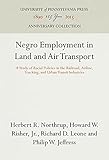Negro Employment in Land and Air Transport : A Study of Racial Policies in the Railroad, Airline, Trucking, and Urban Transit Industries / Herbert R. Northrup, Philip W. Jeffress, Howard W. Risher, Jr., Richard D. Leone.
Material type: TextSeries: Studies of Negro EmploymentPublisher: Philadelphia : University of Pennsylvania Press, [1971]Copyright date: ©1971Description: 1 online resource (704 p.)Content type:
TextSeries: Studies of Negro EmploymentPublisher: Philadelphia : University of Pennsylvania Press, [1971]Copyright date: ©1971Description: 1 online resource (704 p.)Content type: - 9780812276329
- 9781512821116
- 331.6/3/96073
- E185.8 .N45
- online - DeGruyter
- Issued also in print.
| Item type | Current library | Call number | URL | Status | Notes | Barcode | |
|---|---|---|---|---|---|---|---|
 eBook
eBook
|
Biblioteca "Angelicum" Pont. Univ. S.Tommaso d'Aquino Nuvola online | online - DeGruyter (Browse shelf(Opens below)) | Online access | Not for loan (Accesso limitato) | Accesso per gli utenti autorizzati / Access for authorized users | (dgr)9781512821116 |
Frontmatter -- Foreword -- CONTENTS -- Part One THE NEGRO IN THE RAILROAD INDUSTRY -- Part Two THE NEGRO IN THE AIR TRANSPORT INDUSTRY -- Part Three THE NEGRO IN THE TRUCKING INDUSTRY -- Part Four THE NEGRO IN THE URBAN TRANSIT INDUSTRY -- Part Five CONCLUDING ANALYSIS
restricted access online access with authorization star
http://purl.org/coar/access_right/c_16ec
The authors examine both past and current practices and policies influencing black employment in the railroad, airline, trucking, and urban transit industries. Technological unemployment, declining traffic, and discrimination by unions, carriers, and government agencies have reduced both the number and proportion of blacks in the railroad industry, which was once one of the nation's leading employers of blacks.These, same railroading mores have affected black employment in airlines and urban transit in the past but today other forces are working to improve black representation in the former and leading to a heavily black work force in the latter. In the trucking industry, the Teamsters' Union and government policy are keys to Negro employment, with the union dragging its feet in supporting an increased number of black over-the-road drivers. A final section compares the situations in the four industries and forecasts future Negro employment trends in light of the most recent employment data, occupational needs, governmental policy, and other significant factors.
Issued also in print.
Mode of access: Internet via World Wide Web.
In English.
Description based on online resource; title from PDF title page (publisher's Web site, viewed 30. Aug 2022)


